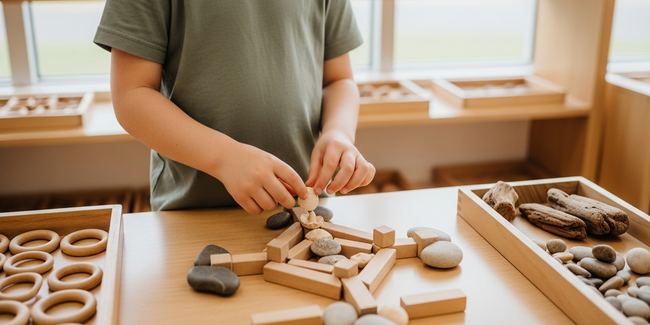In a world filled with glowing screens and scheduled activities, a quiet question often bubbles up for parents: Is my child playing enough? And is that play… actually doing anything? We see the trail of building blocks, the paint-smeared hands, the elaborate worlds constructed from cardboard boxes, and wonder if it’s just a mess or if something more profound is taking place.
At Okinja Early Learning Centre & Kindergarten, our collective 15+ years of experience in early childhood education has given us a definitive answer. Creative play is not a break from learning. It is the most essential, powerful, and neurologically significant learning a young child can possibly do. It is the native language of childhood, and through it, children build the entire architecture for future academic success, emotional resilience, and social connection.
This guide is our invitation to you—a look behind the curtain of a high-quality, play-based philosophy. We won’t just list activities. We will reveal the deep developmental science happening within them, empowering you to see the genius in the game and the learning in the laughter. This is the guidance that transforms how you view play, aligning with the principles of the national Early Years Learning Framework (EYLF) that underpins our entire approach to “belonging, being, and becoming.”
The Unseen Architecture: What’s Really Happening During Creative Play?
Before we dive into the ‘what’, we must first understand the ‘why’. When a child is deeply engaged in creative play, their brain isn’t idle; it’s a symphony of neural activity. They are not just making a mess with dough; they are conducting a complex scientific experiment in physics and chemistry. They are not just dressing up; they are running complex social simulations, exploring empathy, and testing theories about the world.
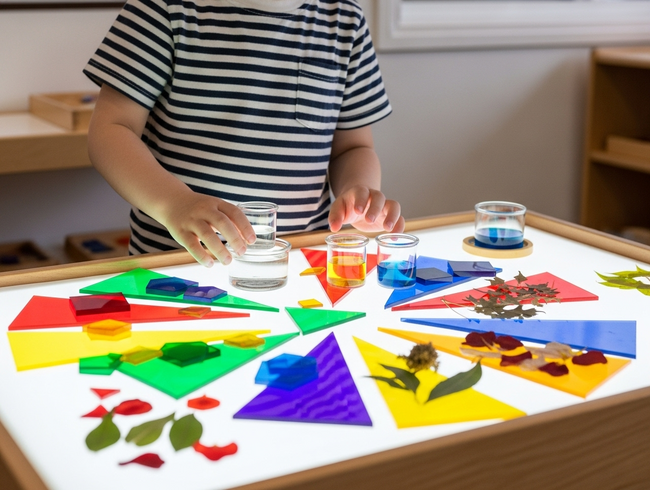
This is why Australia’s National Quality Standard (NQS), specifically Quality Area 1: Educational Program and Practice, places such a strong emphasis on play-based learning. It’s a national recognition that play is the most effective vehicle for development. Every time your child engages in imaginative play, they are strengthening critical pathways for:
- Problem-Solving: Figuring out how to keep a block tower from falling is a lesson in engineering and physics.
- Symbolic Thinking: Understanding that a stick can be a magic wand is the cognitive leap that makes reading (where letters represent sounds) possible.
- Emotional Regulation: Navigating the “rules” of a pretend game with friends teaches negotiation, compromise, and managing frustration in a safe context.
- Language Development: Creating stories, explaining ideas, and listening to peers fuels an explosion in vocabulary and communication skills.
Now, let’s explore how to bring this developmental magic to life through practical, engaging activities you can foster at home or look for in a high-quality early learning environment.
The Indoor Creative Canvas: Fostering Focus and Fine Motor Skills
Indoor play provides a wonderful opportunity for focused, detailed exploration where children can control their environment and dive deep into their interests.
- The Humble Cardboard Box: Never underestimate the power of a large cardboard box. It’s the ultimate open-ended material. It’s not just a box; it’s a rocket ship, a cave, a car, a puppet theatre. This is symbolic thinking in its purest form, where a child’s mind learns the foundational skill of letting one object represent another.
- Process Art (Not Product Art): Provide a range of materials—paint, chalk, crayons, recycled paper, glue—and focus on the process of creating, not the final product. The goal isn’t a perfect fridge-worthy picture; it’s the joy of smearing, mixing colours, and discovering what happens when glue gets sticky. This builds creativity and confidence, freeing a child from the pressure of “getting it right.”
- Homemade Dough & Sensory Bins: A simple recipe of flour, salt, water, and oil creates a fantastic tool for strengthening the small muscles in the hands and fingers, essential for future writing. A bin filled with rice, pasta, or sand, along with scoops and cups, becomes a laboratory for understanding volume, texture, and cause-and-effect. At our centre, we ensure all sensory materials are safe and hygienically managed, a key component of a compliant, high-quality program.
- Storytelling Baskets: Gather a few simple items in a basket—a smooth stone, a colourful scarf, a small animal figure, a key. Pull one item out and begin a story: “Once, there was a little rabbit who found a mysterious key…” Then, invite your child to pull out the next item and add to the tale. This is a powerful way to build narrative skills, vocabulary, and the foundational structures of literacy.
- Junk Modelling & Tinkering Trays: Collect clean, safe recyclables like plastic bottles, cardboard tubes, and bottle caps. Provide tape or child-safe glue and let them build. This is hands-on engineering. They learn about stability, structure, and material properties. It validates their ability to transform the mundane into the magnificent.
The Outdoor Laboratory: Big Movements and Natural Discoveries
The outdoors offers a canvas for limitless discovery, perfect for gross motor development. Here on the Sunshine Coast, our environment is uniquely suited for outdoor nature play, an opportunity our philosophy fully embraces. This belief—that the natural world is a powerful ‘third teacher’—is why our learning spaces are intentionally designed to blur the lines between indoors and out, providing rich sensory experiences that can’t be replicated on a screen.
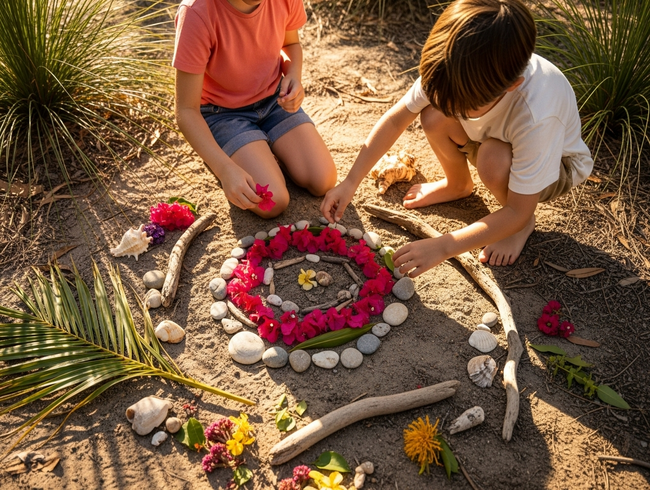
- Potion Making & Mud Kitchens: An old pot, some water, and access to leaves, flowers, sand, and soil create a magical chemistry lab. Children are exploring measurement, mixing, and sensory properties. They are scientists, chefs, and wizards, all while connecting with the natural elements around them.
- Nature Mandalas & Transient Art: Go for a walk and collect interesting natural treasures: leaves of different shapes, fallen flowers, interesting pebbles, and twigs. On a clear patch of ground, arrange them into a beautiful pattern. This activity fosters an appreciation for nature, pattern recognition (a key pre-math skill), and an understanding of impermanence, as the art will eventually be reclaimed by nature.
- Shadow Puppet Theatre: All you need is a sunny day, a wall or a hanging sheet, and your imagination. Use hands, bodies, or cardboard cutouts to create characters and tell stories. This is a beautiful fusion of art and science, teaching children about light, shadow, and perspective.
- Cubby Building with Natural Materials: Using fallen branches, large palm fronds, or old sheets, children can work together to construct their own shelter. This involves heavy lifting (gross motor skills), engineering, collaboration, and a deep, instinctual sense of creating a space of one’s own—a core part of “belonging.”
- Water Painting on Pavement: On a warm day, a bucket of water and a few large paintbrushes are all that’s needed for hours of creative fun. Children can “paint” on walls, paths, and fences. It’s a wonderful, mess-free activity that also teaches a profound scientific lesson about evaporation as their artwork slowly disappears in the sun.
The Social Stage: Building Worlds and Friendships Together
Creative play truly comes alive when children engage with one another. This is where the most critical social and emotional learning happens, directly supporting the EYLF outcome of children becoming “effective communicators” and “confident and involved learners.”
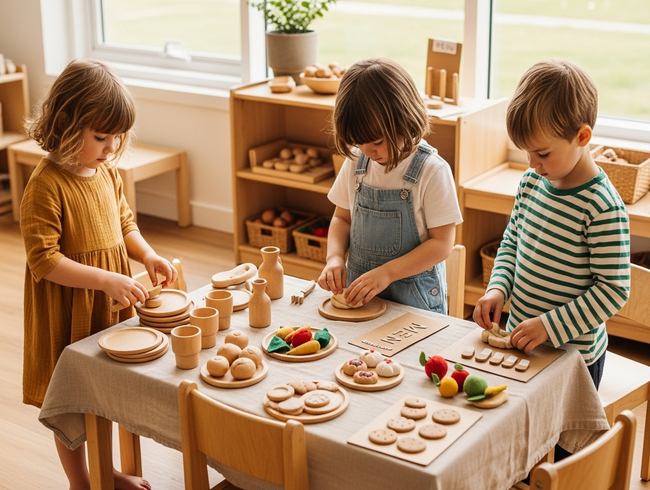
- Elaborate Role-Playing Scenarios: Whether it’s a café, a doctor’s office, or a family of superheroes, dramatic play is a vital social gymnasium. Children practice empathy by taking on another’s perspective, negotiate complex social rules, solve problems collaboratively, and use rich, expressive language.
- Collaborative Mural Painting: Tape a huge piece of paper to a wall or fence and let a group of children create a single piece of art together. They will have to negotiate space, share colours, and build on each other’s ideas. The final product is a testament to their ability to work as a community.
- Group Story Building: Sit in a circle and have one person start a story with a single sentence. The next person adds a sentence, and so on. This hilarious and unpredictable activity teaches active listening, sequential thinking, and the joy of co-creation.
- Building a “City” with Blocks: Provide a large quantity of blocks and invite a group to build a city together. This requires urban planning, resource sharing, and negotiation. “My tower needs that long block!” “Okay, but can we build a bridge to connect our buildings?” It’s a microcosm of community building.
- Putting on a Show: From simple puppet shows to full-blown plays, performance is a fantastic group activity. It involves every stage of creative development: writing the story, creating the costumes and props, practicing the parts, and finally, summoning the courage to perform for an audience.
Your Role: How to Be Your Child’s ‘Philosopher-Guide’ at Home
Your role in this process isn’t to be the director or entertainer, but rather a thoughtful facilitator—a guide who prepares the environment and then steps back to watch the magic unfold.
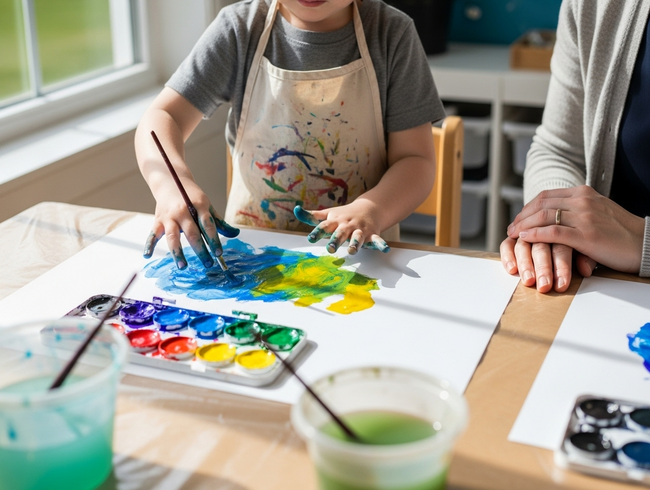
- Prepare the Invitation: Instead of directing an activity, “strew” interesting materials in an inviting way and let your child discover them. This fosters autonomy and curiosity.
- Observe Before Intervening: Watch and listen. Try to understand the story they are creating or the problem they are trying to solve before jumping in to “help.” Often, the struggle is the most valuable part of the learning.
- Ask Open-Ended Questions: Instead of “Are you building a house?”, try “Tell me about what you’re creating here.” This invites a more detailed response and validates their creative vision.
- Value the Process: Praise their effort, their problem-solving, and their creative ideas, not just the final product. “I noticed how carefully you balanced those blocks,” means more than “What a great tower.”
The Okinja Philosophy: Where Play is Purposeful
At Okinja Early Learning Centre & Kindergarten, this deep understanding of creative play is the bedrock of our existence. Our curriculum is not a rigid schedule of activities; it is an emergent, responsive framework guided by the children’s own interests and passions. Our educators are highly qualified observers and facilitators, trained to see the learning in every moment and to thoughtfully extend it.
Our purpose-built centre, with its four distinct playgrounds and seamless indoor-outdoor flow, is designed to be an invitation to explore, create, and discover. We believe that by providing a rich, safe, and inspiring environment, and by trusting in the profound power of play, we are giving children the strongest possible foundation to soar.

The best way to understand the power of our play-based philosophy is to see the joy and deep learning it sparks in person. We invite you to book a tour to see how our expert educators intentionally design experiences that turn a child’s natural curiosity into a foundation for lifelong learning. You’ll see how our thoughtful indoor spaces and enriching outdoor areas work together to support this powerful approach. Contact Okinja ELC on 07 5479 2222 to arrange your visit.

